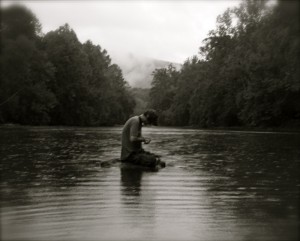 There are a lot of things that get in the way of fishing, but rain should not be one of them. Some of my most productive days on the water have been when skies are drizzly and gray or even when it’s pouring. In the Chesapeake, where fishing pressure has a significant impact on fish-feeding behavior, rain keeps the crowds at home and opens up those over-fished hot-spots where the bite can be impossible when the weather is nice. This weekend however, out-fishing the crowds was not part of the equation. My boys and I had planned a stream fishing trip in the East Tennessee Mountains, and we were not about to let a little thing like a forecasted 4-inch deluge stand in the way.
There are a lot of things that get in the way of fishing, but rain should not be one of them. Some of my most productive days on the water have been when skies are drizzly and gray or even when it’s pouring. In the Chesapeake, where fishing pressure has a significant impact on fish-feeding behavior, rain keeps the crowds at home and opens up those over-fished hot-spots where the bite can be impossible when the weather is nice. This weekend however, out-fishing the crowds was not part of the equation. My boys and I had planned a stream fishing trip in the East Tennessee Mountains, and we were not about to let a little thing like a forecasted 4-inch deluge stand in the way.
It may seem out of context to post a southern Appalachian stream-fishing report to a website dedicated to fishing in the Chesapeake Bay. I hope you’ll grant me the indulgence because most of the techniques I use to fish the Chesapeake were honed over many years of fishing in the southeast. One of the most important secrets to my Bay fishing success has been using the tidal currents to my advantage. I learned to do that in the rivers and creeks of the mountains. For example, a lure retrieved downstream with the current will always out-fish one worked upstream against the current. But an up-current cast at a forty-five degree angle to the direction of the flow is better still, because the lure moves more slowly, looks more natural, and stays in the strike zone longer. It’s a basic principle that every experienced stream fisherman knows – probably the origin of the term “angling,” – but surprisingly overlooked by many salt-water fishermen.
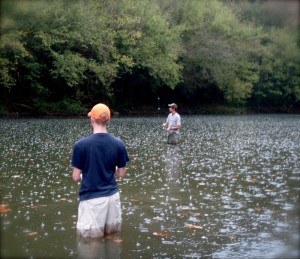
The southeastern U.S. has been swamped lately. Tennessee and Georgia got the worst of it with significant flooding in some of the metropolitan areas. Many of the creeks and rivers are swollen and muddy; some are well over their banks. Since we had our mind’s set to stream fish, I figured our best hope for clearer water was to gain some elevation on the northern side of the Clinch range where the steep forested valleys prevent soil erosion and keep the runoff relatively clean. We decided to drive east to Hancock County near the Tennessee-Virginia state line.
Cory, Jacob and I loaded our gear into Jacob’s Montero and headed out of Knoxville on US hwy 33, arriving at the Powell River near Mulberry Grove in the early afternoon. Daniel couldn’t join us on this trip because he was playing a bluegrass gig in Los Angeles. We were pleasantly surprised to see the water relatively clear and the river only slightly up. We used ultra-light spinning outfits with four or six-pound-test line to cast either tiny Rebel crawfish crankbaits or Panther Martin inline spinners. Both of those lures are great for stream fishing.
TIP: Inline spinners can be very effective in almost any fishing situation. No matter where I’m fishing – the Bay, lakes, or streams – I keep inline spinners in my box as my lure of last resort. When you can’t get fish to hit by any other method, try a spinner.
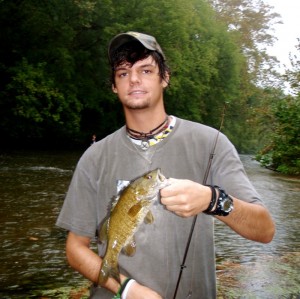 We fanned out across the stream in an area where the water was relatively swift with some deeper holes scattered along the edges. This Powell isn’t very wide in this region, so we could fish almost the entire river from either side. Our biggest challenge was getting under the low-hanging branches and fishing around the many leaves that were constantly floating downstream. Just as we started casting, the rain, which had let up on our drive east, came back with a vengeance. It created thousands of tiny bubbles on the surface of the water. The clouds were so low we couldn’t see the ridge tops. We could hear thunder echoing off the distant mountains and rolling down through the valleys, but the storms seemed far enough away. I made a long cast into a deep pool, felt a strike and set the hook into a solid fish. It turned out to be a two-pound walleye, a nice surprise since they are relatively unusual in this section of the river. Unfortunately I dropped the fish while fumbling for my camera and didn’t get a picture.
We fanned out across the stream in an area where the water was relatively swift with some deeper holes scattered along the edges. This Powell isn’t very wide in this region, so we could fish almost the entire river from either side. Our biggest challenge was getting under the low-hanging branches and fishing around the many leaves that were constantly floating downstream. Just as we started casting, the rain, which had let up on our drive east, came back with a vengeance. It created thousands of tiny bubbles on the surface of the water. The clouds were so low we couldn’t see the ridge tops. We could hear thunder echoing off the distant mountains and rolling down through the valleys, but the storms seemed far enough away. I made a long cast into a deep pool, felt a strike and set the hook into a solid fish. It turned out to be a two-pound walleye, a nice surprise since they are relatively unusual in this section of the river. Unfortunately I dropped the fish while fumbling for my camera and didn’t get a picture.
We continued wading upstream in the pouring rain. I heard Jacob whoop and looked back to see his rod deeply bent as he fought a nice smallmouth. He had lingered behind to work a stretch of fast water Cory and I had already fished, but one that obviously deserved more attention. All my boys are excellent fishermen. Fishing in the Bay has provided me with the opportunity to watch a lot of people fish and see many different skill levels. I’m always surprised at the natural fishing talent these guys have. They seem to instinctively recognize areas that are likely to hold fish.
Before much longer Cory had also landed a fat river bronzeback. As he was taking off his fish I took the opportunity to leapfrog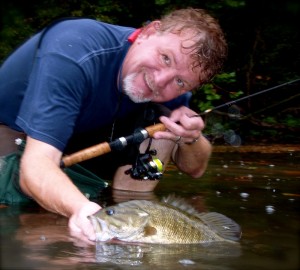 in front of him to probe a deep hole beneath a big sycamore tree. I skipped my orange and gold one-eighth ounce spinner under the low hanging branches, gave my rod-tip a quick snap to get the blade turning, and immediately felt the thump of a solid fish. The healthy smallmouth lit out downstream like a rifle shot. Cory looked up in time to realize he was between me and the fish and about to be decapitated! He quickly ducked down low. Just about the time the line cleared Cory’s head the bass hit the sky jumping three feet out of the water. From my angle it looked like it leapt right over him. I’d love to have had that moment on video. Spectacular action like that is unforgettable.
in front of him to probe a deep hole beneath a big sycamore tree. I skipped my orange and gold one-eighth ounce spinner under the low hanging branches, gave my rod-tip a quick snap to get the blade turning, and immediately felt the thump of a solid fish. The healthy smallmouth lit out downstream like a rifle shot. Cory looked up in time to realize he was between me and the fish and about to be decapitated! He quickly ducked down low. Just about the time the line cleared Cory’s head the bass hit the sky jumping three feet out of the water. From my angle it looked like it leapt right over him. I’d love to have had that moment on video. Spectacular action like that is unforgettable.
–
Tip: When fishing inline spinners, you need a swivel to prevent your line from twisting, but don’t use a snap swivel directly on the lure. Keen-eyed fish will see it in clear water. Instead, cut off the wire snap part with your pliers and use it like an in-line swivel tied to your line up about a foot away from your lure. You’ll get a lot more strikes and catch more fish!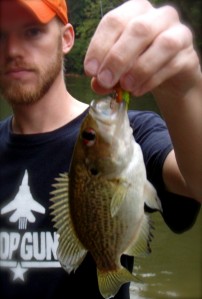
While I was landing and releasing my fish the boys waded on upstream to an area where a smaller creek entered the river near the end of a long stretch of still water. The water flowing from the little branch was colder and clearer than the river creating a thin layer of fog that usually signifies stratification in the river that will attract bait. Both the guys hooked up on their first cast. Cory got a nice redeye (rock bass) and Jacob landed another little smallie. We got a picture of both fish together before releasing them. They kept casting into the same area with almost every shot resulting in a strike including more nice-sized redeye. I finally caught up and got into the action as well. I think we landed eight fish out of that one area.
Sunset comes early in the mountains. Since our light was fading and we were wet and cold, we decided to call it a day. It was a little farther walk back down the road than we thought. Even though air temperatures were in the 60s, by the time we got back to the SUV we were all suffering from the first stages of hypothermia. We crossed the mountains into the little town of Sneedville where we decided to stop at an out-of-the-way country restaurant. We noticed a few stares as we walked in. Everybody knows everybody else in that part of the country and we were clearly 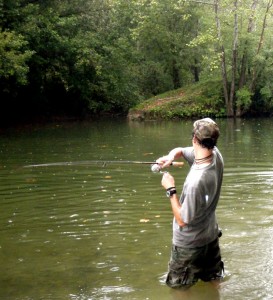 strangers. To make matters worse, Jacob and I were both shivering uncontrollably while a little pool had formed on the floor beneath Cory’s chair when he sat down in his wet shorts. I figured it was just a matter of time until someone called the local sheriff about the three Meth-heads at Cookies Restaurant.
strangers. To make matters worse, Jacob and I were both shivering uncontrollably while a little pool had formed on the floor beneath Cory’s chair when he sat down in his wet shorts. I figured it was just a matter of time until someone called the local sheriff about the three Meth-heads at Cookies Restaurant.
When the waitress came over I summoned my best east Tennessee accent and explained loudly enough for everyone to hear that we had been fishing the river and didn’t think to bring dry clothes. She bought the story and took pity on us. On her next trip she brought over a pot of steaming coffee, then pulled up a chair and sat down beside us to take our order, a clear signal to everyone there that we fit in. The food was hot and delicious, a very nice ending to a fun afternoon of rainy-day fishing in the mountains.




ya’ll Marylanders lock up the Sudafed…hate I missed this one.
Shawn;
Excellent fishing report and an even better story. It’s a nice change of venue from the usual Chesapeake Bay articles. And it’s always great seeing you out there with “the boys.”
Mark
Shawn: Really enjoyed your “Smoky Mountain Rain” fishing report. I spend most of my time fishing the Susquehanna river here in Lancaster, PA for smallmouth, fishing has been great , catching quite a few 3 – 4lb fish. Only recently started fishing the Chesapeake Bay thanks for all the reports. Greg
Always a great read. Thanks!!
Good article. I grew up fishing the waters of western North Carolina around Boone, primarily the New River and the Watauga River, so I can relate to your trip. Some of the best memories are fishing during or after rains with the water up or rising. I followed much the same down stream technique but my lure of choice was a black rooster tail spinner. That was before Rebel crawfish were even heard of-at least by us, but in later years they were, and still are, very effective for trout, red eyes and smallies. I haven’t heard anyone talking about catching redeyes in a coon’s age-except my brothers who still live there that is. We also used Crippled Killers, a top water plug with propellers on each end. The were great for both smallies and redeyes. More often than not though, we would seine minnows or go to a spring branch and catch a bunch of “lizards” for bait. I posted a short article on Tidal Fish about one experience lizard fishing with Grandpa.
Good Fishing,
Jerry